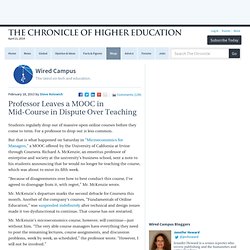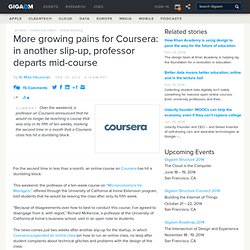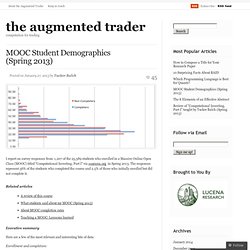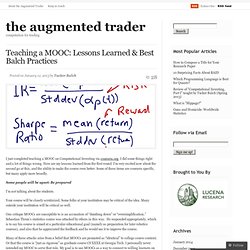

Www2.ed.gov/rschstat/eval/tech/evidence-based-practices/finalreport.pdf. ZSRx. Abstract: MOOCs Are Really Great! But What’s Next? Simply Statistics Podcast #6: Data Analysis MOOC Post-mortem. Professor Leaves a MOOC in Mid-Course in Dispute Over Teaching - Wired Campus. Students regularly drop out of massive open online courses before they come to term.

For a professor to drop out is less common. But that is what happened on Saturday in “Microeconomics for Managers,” a MOOC offered by the University of California at Irvine through Coursera. Richard A. McKenzie, an emeritus professor of enterprise and society at the university’s business school, sent a note to his students announcing that he would no longer be teaching the course, which was about to enter its fifth week. “Because of disagreements over how to best conduct this course, I’ve agreed to disengage from it, with regret,” Mr. Mr. Mr. Daphne Koller, one of Coursera’s founders, said by e-mail that Mr. Gary Matkin, the dean for distance education at Irvine, said the problem had stemmed from Mr. “In Professor McKenzie’s view, for instance, uninformed or superfluous responses to the questions posed in the discussion forums hobbled the serious students in their learning,” said Mr.
Ms. Mr. More growing pains for Coursera: in another slip-up, professor departs mid-course. For the second time in less than a month, an online course on Coursera has hit a stumbling block.

This weekend, the professor of a ten-week course on “Microeconomics for Managers,” offered through the University of California at Irvine Extension program, told students that he would be leaving the class after only its fifth week. “Because of disagreements over how to best to conduct this course, I’ve agreed to disengage from it, with regret,” Richard McKenzie, a professor at the University of California at Irvine’s business school, said in an open note to students. The news comes just two weeks after another slip-up for the startup, in which Coursera suspended an online class (on how to run an online class, no less) after student complaints about technical glitches and problems with the design of the class. Professor wasn’t accustomed to large, diverse audience.
Oh, the irony: Coursera suspends online course about how to run an online course. A Tale of Two MOOCs @ Coursera: Divided by Pedagogy. The Web as a classroom is transforming how people learn, is driving the need for new pedagogy; two recently launched courses at Coursera highlight what happens when pedagogical methods fail to adapt.

Divided pedagogy I wrote recently about the Fundamentals of Online: Education [FOE] the Coursera course that was suspended after its first week and is now in MOOC hibernation mode. Over thirty thousands students signed up for the course hoping to learn how to develop an online course. It was a technical malfunction when students were directed to sign-up for groups through a Google Doc that shuttered the course, along with hundreds of student complaints about lack of clear instructions, and poor lecture quality. The course was suspended on February 2, and there has been no word yet as to when it will resume :(.
The Tale of the Two What made e-Learning and Digital Cultures successful and FOE not? Our current higher education system is grounded in behaviorist and cognitive theories. References. MOOC Student Demographics. I report on survey responses from 1,207 of the 25,589 students who enrolled in a Massive Online Open Class (MOOC) titled “Computational Investing, Part I” via coursera.org in Spring 2013.

The responses represent 56% of the students who completed the course and 2.5% of those who initially enrolled but did not complete it. Related articles Executive summary. About MOOC Completion Rates: The Importance of Student Investment. I just finished teaching a Massive Online Open Class (MOOC) titled “Computational Investing, Part I” via coursera.org. 53,000 people “enrolled,” which is to say they clicked a “sign up” button.

How many finished? Related post regarding lessons learned Completion rates are low, but that statistic is misleading Much of the criticism of MOOCs centers on supposedly low completion rates. And these rates do seem low when compared to completion rates of regular university courses. Teaching a MOOC: Lessons Learned & Best Balch Practices. I just completed teaching a MOOC on Computational Investing via coursera.org.

I did some things right and a lot of things wrong. Here are my lessons learned from the first round. I’m very excited now about the second go at this, and the ability to make the course even better. Some of these items are coursera specific, but many apply more broadly. Some people will be upset: Be prepared. The Professors Behind the MOOC Hype - Technology. Dave Chidley for The Chronicle Paul Gries, of the U. of Toronto, has taught MOOCs on computer science.

By Steve Kolowich What is it like to teach 10,000 or more students at once, and does it really work? The largest-ever survey of professors who have taught MOOCs, or massive open online courses, shows that the process is time-consuming, but, according to the instructors, often successful. Nearly half of the professors felt their online courses were as rigorous academically as the versions they taught in the classroom. The survey, conducted by The Chronicle, attempted to reach every professor who has taught a MOOC. Hype around these new free online courses has grown louder and louder since a few professors at Stanford University drew hundreds of thousands of students to online computer-science courses in 2011. Princeton University's Robert Sedgewick is one of them.